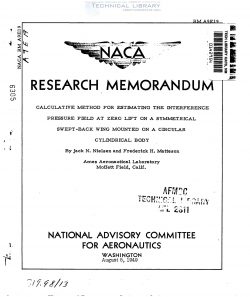naca-rm-a9e19
- Version
- 84 Downloads
- 1.80 MB File Size
- 1 File Count
- April 20, 2017 Create Date
- April 20, 2017 Last Updated
National Advisory Committee for Aeronautics, Research Memorandum - Calculative Method for Estimating the Interference Pressure Field at Zero Lift on a Symmetrical Swept Back Wing Mounted on a Circular Cylindrical Body

An approximate method is presented for calculating the inter— ‘_
ference pressure distribution at zero lift of a symmetrical swept—
back wing mounted on a circular cylindrical body with the chord plane
of the wing passing through the axis of the body. The method
employed. is based on linear theory and is an approximate first-order
method. An example illustrating the method is presented. for a wing-
body combination consisting of a circular cylindrical body and an
untapered wing swept back 60°. The wing considered. in the example
has a double—wedge section with the maximum thickness at the
midchord, a chord. equal to twice the body diameter, and 'a spanwise
distance from the wing—body juncture to‘ the wing tip of two body
diameters. The effects of a body nose on the wing pressure distribu—
tion are not considered in determining the pressure drag of the wing
in combination. It is found that the pressure drag of the wing in
combination is less than that of the two exposed half—wings Joined
together.
At subsonic speeds, wing—body interference has important effects
on the aerodynamic characteristics of an airplane. At supersonic
speeds, wing—body interference assumes even greater importance because
of the relatively large bodies and. small wings usually specified for
aircraft designed for flight at such speeds. Swept—back wings
probably have greater interference effects at supersonic speeds than
unswept or swept—forward wings because greater areas of swept—back
wings lie within the region of influence of the wing—body juncture.
Past work on wing—body interference at supersonic speeds has been
largely confined to lift and moment interference. Using the concepts
developed by R. T. Jones in his low~aspectaratio, triangular—wing
theory (reference 1), Spreiter (reference 2) has determined the
effect of a pointed, slender body of revolution on the lift—curve
slope and center—offpressure location of.a wingébody configuration.
Browne, Friedman, and Hodes (reference 3), using the methods of
conical supersonic flow, have determined the loading on a triangular—
wing conical—body combination with a common apex. Ferrari (refer—
ence A) has analyzed the lift and moment interference between a flat
rectangular lifting surface and a pointed body of revolution.
| File | Action |
|---|---|
| naca-rm-a9e19 Calculative Method for Estimating the Interference Pressure Field at Zero Lift on a Symmetrical Swept Back Wing Mounted on a Circular Cylindrical Body.pdf | Download |
Comment On This Post